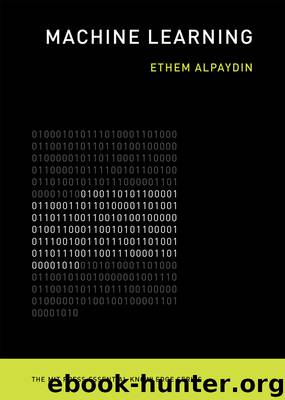Machine Learning by Ethem Alpaydin

Author:Ethem Alpaydin
Language: eng
Format: epub, azw3
Publisher: The MIT Press
Published: 2016-09-06T04:00:00+00:00
Neural Networks as a Paradigm for Parallel Processing
Since the 1980s, computer systems with thousands of processors have been commercially available. The software for such parallel architectures, however, has not advanced as quickly as hardware. The reason for this is that almost all our theory of computation up to that point was based on serial, single-processor machines. We are not able to use the parallel machines in their full capacity because we cannot program them efficiently.
There are mainly two paradigms for parallel processing. In single instruction, multiple data (SIMD) machines, all processors execute the same instruction but on different pieces of data. In multiple instruction, multiple data (MIMD) machines, different processors may execute different instructions on different data. SIMD machines are easier to program because there is only one program to write. However, problems rarely have such a regular structure that they can be parallelized over a SIMD machine. MIMD machines are more general, but it is not an easy task to write separate programs for all the individual processors; additional problems arise that are related to synchronization, data transfer between processors, and so forth. SIMD machines are also easier to build, and machines with more processors can be constructed if they are SIMD. In MIMD machines, processors are more complex, and a more complex communication network must be constructed for the processors to exchange data arbitrarily.
Assume now that we can have machines where processors are a little bit more complex than SIMD processors but not as complex as MIMD processors. Assume that we have simple processors with a small amount of local memory where some parameters can be stored. Each processor implements a fixed function and executes the same instructions as SIMD processors; but by loading different values into its local memory, each processor can be doing different things and the whole operation can be distributed over such processors. We will then have what we can call neural instruction, multiple data (NIMD) machines, where each processor corresponds to a neuron, local parameters correspond to its synaptic weights, and the whole structure is a neural network. If the function implemented in each processor is simple and if the local memory is small, then many such processors can be fit on a single chip.
The problem now is to distribute a task over a network of such processors and to determine the local parameter values. This is where learning comes into play: we do not need to program such machines and determine the parameter values ourselves if such machines can learn from examples.
Thus, artificial neural networks are a way to make use of the parallel hardware we can build with current technology and—thanks to learning—they need not be programmed. Therefore, we also save ourselves the effort of programming them.
Download
This site does not store any files on its server. We only index and link to content provided by other sites. Please contact the content providers to delete copyright contents if any and email us, we'll remove relevant links or contents immediately.
Algorithms of the Intelligent Web by Haralambos Marmanis;Dmitry Babenko(16235)
Jquery UI in Action : Master the concepts Of Jquery UI: A Step By Step Approach by ANMOL GOYAL(9387)
Test-Driven Development with Java by Alan Mellor(7735)
Data Augmentation with Python by Duc Haba(7609)
Principles of Data Fabric by Sonia Mezzetta(7378)
Learn Blender Simulations the Right Way by Stephen Pearson(7294)
Microservices with Spring Boot 3 and Spring Cloud by Magnus Larsson(7137)
Hadoop in Practice by Alex Holmes(6587)
RPA Solution Architect's Handbook by Sachin Sahgal(6517)
The Infinite Retina by Robert Scoble Irena Cronin(6216)
Big Data Analysis with Python by Ivan Marin(5934)
Life 3.0: Being Human in the Age of Artificial Intelligence by Tegmark Max(5516)
Pretrain Vision and Large Language Models in Python by Emily Webber(4894)
Infrastructure as Code for Beginners by Russ McKendrick(4653)
Functional Programming in JavaScript by Mantyla Dan(4436)
WordPress Plugin Development Cookbook by Yannick Lefebvre(4382)
The Age of Surveillance Capitalism by Shoshana Zuboff(4247)
Embracing Microservices Design by Ovais Mehboob Ahmed Khan Nabil Siddiqui and Timothy Oleson(4148)
Applied Machine Learning for Healthcare and Life Sciences Using AWS by Ujjwal Ratan(4135)
